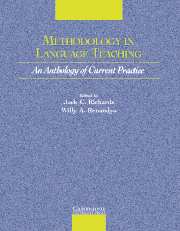Book contents
- Frontmatter
- Contents
- Acknowledgments
- Introduction
- Section I Approaches to Teaching
- Section 2 Lesson Planning and Classroom Management
- Section 3 Classroom Dynamics
- Section 4 Syllabus Design and Instructional Materials
- Section 5 Task and Project Work
- Section 6 Learning Strategies
- Section 7 Teaching Grammar
- Section 8 Teaching Pronunciation
- Section 9 Teaching Speaking
- Section 10 Teaching Listening
- Section 11 Teaching Vocabulary
- Section 12 Teaching Reading
- Section 13 Teaching Writing
- Section 14 Assessment
- Section 15 Technologies in the Classroom
- Section 16 Professional Development
- Credits
- Author Index
- Subject Index
Section 5 - Task and Project Work
Published online by Cambridge University Press: 10 November 2010
- Frontmatter
- Contents
- Acknowledgments
- Introduction
- Section I Approaches to Teaching
- Section 2 Lesson Planning and Classroom Management
- Section 3 Classroom Dynamics
- Section 4 Syllabus Design and Instructional Materials
- Section 5 Task and Project Work
- Section 6 Learning Strategies
- Section 7 Teaching Grammar
- Section 8 Teaching Pronunciation
- Section 9 Teaching Speaking
- Section 10 Teaching Listening
- Section 11 Teaching Vocabulary
- Section 12 Teaching Reading
- Section 13 Teaching Writing
- Section 14 Assessment
- Section 15 Technologies in the Classroom
- Section 16 Professional Development
- Credits
- Author Index
- Subject Index
Summary
INTRODUCTION
Few would question the need to make language classrooms a place where genuine and meaningful communication takes place and not simply one where students “practice” language for its own sake. This emphasis on making meaning the priority in syllabus design and methodology underlies many aspects of contemporary approaches to language teaching. For example:
Communicative Language Teaching: The need to make communication the primary focus of teaching materials and classroom activities has long been a core assumption of communicative methodology.
Task-based language teaching: The use of tasks that serve to facilitate meaningful communication and interaction lies at the heart of various proposals for “task-based instruction,” which is an attempt to apply principles from second language acquisition research to language teaching.
Content-based instruction: A focus on real-world content and the understanding and communication of information through language is the key to second language learning and teaching in this approach.
The articles in this section focus on task work and project work as different ways of creating opportunities for language learning through problem solving, cooperative learning, collaboration, and negotiation of meaning – processes which many believe are central to second language acquisition.
Many traditional approaches to language teaching are based on a focus on grammatical form and a cycle of activities that involves presentation of a new language item, practice of the item under controlled conditions, and a production phase in which the learners try out the form in a more communicative context.
Information
- Type
- Chapter
- Information
- Methodology in Language TeachingAn Anthology of Current Practice, pp. 93 - 95Publisher: Cambridge University PressPrint publication year: 2002
